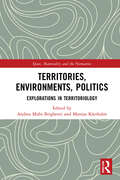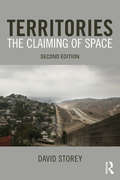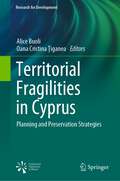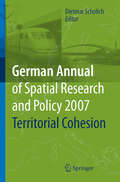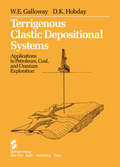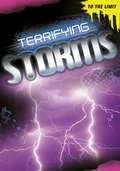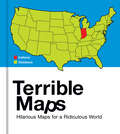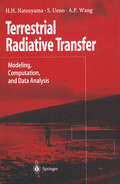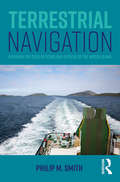- Table View
- List View
Territories, Environments, Politics: Explorations in Territoriology
by Andrea Mubi Brighenti Mattias KärrholmThis collection seeks to illustrate the state of the art in territoriological research, both empirical and theoretical. The volume gathers together a series of original, previously unpublished essays exploring the newly emerging territorial formations in culture, politics and society. While the globalisation debate of the 1990s largely pivoted around a ‘general deterritorialisation’ hypothesis, since the 2000s it has become apparent that, rather than effacing territories, global connections are added to them, and represent a further factor in the increase of territorial complexity. Key questions follow, such as: How can we further the knowledge around territorial complexities and the ways in which different processes of territorialisation co-exist and interact, integrating scientific advances from a plurality of disciplines? Where and what forms does territorial complexity assume, and how do complex territories operate in specific instances? Which technological, political and cultural facets of territories should be tackled to make sense of the life of territories? How and by what different or combined methods can we describe territories, and do justice to their articulations and meanings? How can the territoriological vocabulary relate to contemporary social theory advancements such as ANT, the ontological turn, the mobilities paradigm, sensory urbanism, and atmospheres research? How can territorial phenomena be studied across disciplinary boundaries? Territories, Environments, Politics casts a fresh perspective onto a number of key contemporary socio-spatial phenomena. Refraining from the attempt to ossify territoriology into some disciplinary straightjacket, the collection aims to illustrate the scope of current territoriological research, its domain, its promises, its theoretical advancements, and its methodological reflection in the making. Scholars interested in social research will find in this collection a rich and imaginative theoretical-methodological toolkit. Students in human geography, anthropology and sociology, socio-legal studies, architecture and urban planning will find Territories, Environments, Politics of interest.
Territories: The Claiming of Space
by David StoreyPolitics and political relationships underpin the world we live in. From the division of the earth’s surface into separate states to the placement of ‘keep out’ signs, territorial strategies to control geographic space can be used to assert, maintain or resist power and as a force for oppression or liberation. Forms of exclusion can be consolidated and reinforced through territorial practices, yet they can also be resisted through similar means. Territoriality can be seen as the spatial expression of power, with borders dividing those inside from those outside. The extensively revised and updated second edition continues to provide an introduction to theories of territoriality and the outcomes of territorial control and resistance. It explores the construction of territories and the conflicts which often result using a range of examples drawn from various spatial scales and from many different countries. It ranges in coverage from conflicts over national territory (such as Israel/Palestine, Northern Ireland, South Ossetia) to divisions of space based around class, gender and race. While retaining the key elements of the first edition, this new edition covers contemporary debates on nationalism, territorialization, globalization and borders. It updates the factual content to explore the territorial consequences of ‘9/11’, the ‘war on terror’ and the conflicts in Iraq and Afghanistan. It also examines migration, refugees, the territorial expansion of the European Union, and territorial divisions in the home and workplace. The book emphasizes the underlying processes associated with territorial strategies and raises important questions relating to place, culture and identity. Key questions emerge concerning geographic space, who is ‘allowed’ to be in particular spaces and who is barred, discouraged or excluded. Written from a geographical perspective, the book is inter-disciplinary, drawing on ideas and material from a range of academic disciplines including, history, political science, sociology, international relations, cultural studies. Each chapter contains boxed case studies, illustrations and guides to further reading.
Territories: The Claiming of Space
by David StoreyPolitics and political relationships underpin the world we live in. From the division of the earth’s surface into separate states to the placement of ‘keep out’ signs, territorial strategies to control geographic space can be used to assert, maintain or resist power and as a force for oppression or liberation. Forms of exclusion can be consolidated and reinforced through territorial practices, yet they can also be resisted through similar means. Territoriality can be seen as the spatial expression of power, with borders dividing those inside from those outside. The extensively revised and updated second edition continues to provide an introduction to theories of territoriality and the outcomes of territorial control and resistance. It explores the construction of territories and the conflicts which often result using a range of examples drawn from various spatial scales and from many different countries. It ranges in coverage from conflicts over national territory (such as Israel/Palestine, Northern Ireland, South Ossetia) to divisions of space based around class, gender and race. While retaining the key elements of the first edition, this new edition covers contemporary debates on nationalism, territorialization, globalization and borders. It updates the factual content to explore the territorial consequences of ‘9/11’, the ‘war on terror’ and the conflicts in Iraq and Afghanistan. It also examines migration, refugees, the territorial expansion of the European Union, and territorial divisions in the home and workplace. The book emphasizes the underlying processes associated with territorial strategies and raises important questions relating to place, culture and identity. Key questions emerge concerning geographic space, who is ‘allowed’ to be in particular spaces and who is barred, discouraged or excluded. Written from a geographical perspective, the book is inter-disciplinary, drawing on ideas and material from a range of academic disciplines including, history, political science, sociology, international relations, cultural studies. Each chapter contains boxed case studies, illustrations and guides to further reading.
Territorial Water Cooperation in the Central Plateau of Iran
by Majid Labbaf KhaneikiThis book tries to answer the question how different communities in such an arid area as the Iranian central plateau could have shared their limited water resources in a perfect harmony and peace over the course of history. They invented some indigenous technologies as well as cooperative socio-economic systems in order to better adapt themselves to their harsh environment where the scarce water resources had to be rationed among the different communities as sustainably as possible. Those stories hold some lessons for us on how to adjust our needs to our geographical possibilities while living side by side with other people. This work gives insight into the indigenous adaptation strategies through the territorial water cooperation, and describes how water can appear as a ground for cooperation. It explains the water supply systems and social aspects of water in central Iran. Topics include the territorial water cooperation, qanat’s, the traditional water management and sustainability, the socio-economic context, the sustainable management of shared aquifers system and more.
Territorial Policy and Governance: Alternative Paths (Regions and Cities)
by Iain Deas Stephen HincksIn response to both policy and conceptual debates, alternative narratives have begun to emerge about territorial governance and policymaking. As local and regional policy actors strive to respond to the geographically uneven effects of the economic crises of the early twenty-first century, a crucial question emerges: what are the opportunities and challenges presented by alternative forms of territorially based governance and policy? The aim of this edited volume, therefore, is critically to explore the opportunities and challenges presented by different forms of territorial policy and governance. Drawing on conceptual debates and empirical research from the United Kingdom and other international contexts, the contributors engage with issues around the politics and governance of territorial development, economic development, planning and regeneration and the environment. Territorial Policy and Governance addresses the question of how alternative forms of territorial governance and policy can help to shape patterns of urban and regional development, highlighting the related opportunities, constraints and challenges that confront their operationalisation. This book will be essential reading for international audiences with an interest in territorial development, governance, politics, human geography and planning and regeneration.
Territorial Policy and Governance: Alternative Paths (Regions and Cities)
by Iain Deas Stephen HincksIn response to both policy and conceptual debates, alternative narratives have begun to emerge about territorial governance and policymaking. As local and regional policy actors strive to respond to the geographically uneven effects of the economic crises of the early twenty-first century, a crucial question emerges: what are the opportunities and challenges presented by alternative forms of territorially based governance and policy? The aim of this edited volume, therefore, is critically to explore the opportunities and challenges presented by different forms of territorial policy and governance. Drawing on conceptual debates and empirical research from the United Kingdom and other international contexts, the contributors engage with issues around the politics and governance of territorial development, economic development, planning and regeneration and the environment. Territorial Policy and Governance addresses the question of how alternative forms of territorial governance and policy can help to shape patterns of urban and regional development, highlighting the related opportunities, constraints and challenges that confront their operationalisation. This book will be essential reading for international audiences with an interest in territorial development, governance, politics, human geography and planning and regeneration.
Territorial Impact Assessment: Cohesion, Development, Impact Assessment And Cooperation (Advances in Spatial Science)
by Eduardo MedeirosThis book presents a comprehensive debate and analysis of existing Territorial Impact Assessment (TIA) methodologies, designed under the auspices of the ESPON programme since the mid-2000s. This is intended to serve as a TIA handbook for the reader, to better understand the main differences, advantages and shortcomings of each presented TIA methodology. It also serves as a manual for professors and students in the field of policy evaluation, and territorial analysis, as it presents concrete examples of the implementation of each TIA methodology, their formulas and intrinsic evaluation elements. The purpose of policy evaluation methodologies is to check the main effects of private and public investments, in order to report back to policymakers and citizens on their efficiency and effectiveness. Over the past decades, both in Europe and worldwide, there has been an increasingly awareness of the need to implement/reinforce policy evaluation practices, at all territorial levels. At the same time, it has become widely accepted that many policy interventions produce impacts in more than one dimensions of territorial development. In this context, the use of a holistic and territorial approach for policy impact assessment evaluation has rapidly been adopted by the European Commission as a mainstream policy evaluation procedure.
Territorial Fragilities in Cyprus: Planning and Preservation Strategies (Research for Development)
by Alice Buoli Oana Cristina ŢiganeaIn this book, the authors present a combination of research-by-design, place-based, and policy-oriented approaches to the territorial fragilities of Nicosia. Nicosia, in Cyprus, is a city divided. Since 1974, a 180 km long Buffer Zone has separated the Turkish Republic of Northern Cyprus (TRNC) and the Republic of Cyprus (RoC). This "open wound" cuts through the city's historical center, crossing the Venetian walls, a key cultural heritage asset, and impacting the city's spatial and cultural identity. Outcomes of an inter-doctoral research initiative, this edited book documents the local realities of the divided city and tests scenarios and spatial patterns of intervention to cope with the partition through the enhancement of local cultural heritage.The book targets an academic audience, architects, urban planners, heritage preservation professionals and policymakers, providing a transferable research method relevant to those approaching a complex, fragile, and contested "border territory".
Territorial Development and Water-Energy-Food Nexus in the Global South: A Study for the Maputo Province, Mozambique (Research for Development)
by Laura Montedoro Alice Buoli Alessandro FrigerioThis volume collects the results from the Politecnico di Milan’s award-winning “Boa_Ma_Nhã, Maputo!” research-by-design project, which studied various transdisciplinary approaches to development in the context of the Global South. The challenges of urbanization are well known, but that only goes so far in aiding implementation. From local considerations like water access and housing rights to global issues like climate change, territorial development demands solutions that address the needs of the specific population while keeping such goals as sustainability and inclusion in mind. By focusing on a number of towns within the Maputo Province of Mozambique, and thus addressing many of the issues endemic to Sub-Saharan Africa, the research, structurally presented so as to aid those who may require introduction to the issue, makes a clear case in favor of always keeping the Water-Energy-Food (WEF) Nexus in mind when formulating development strategies for improving people’s lives, as well as the wisdom of marrying academic findings with the insights accrued by local NGOs and institutions, thereby expanding the potential idea bank beyond the Eurocentric status quo that has tended to dominate the field.
Territorial Crisis Management: From Emergency to Reconstruction
by Richard Laganier Yvette VeyretOur societies have become very crisis-prone. This book explores crises and the methods of anticipation, management and reconstruction, and considers a risk-crisis-territorial development continuum. The aim is to better understand a widely used concept and clarify the methods of action in the field of crisis management. The different forms of learning proposed to better face future crises are also questioned.This book invites us to analyze the resources available to support crisis management and reconstruction, and consider the unequal access to these resources in different territories in order to design future territorial strategies. This often results in a form of territorial inertia after the crises. However, some innovate, imagine renewed territories, prepare for reconstruction, or even recompose territories now in order to make them more resilient. The crisis can then be the driving force or the accelerator of these changes and contribute to the emergence of new practices, or even new urban and territorial utopias.
Territorial Crisis Management: From Emergency to Reconstruction
by Yvette Veyret Richard LaganierOur societies have become very crisis-prone. This book explores crises and the methods of anticipation, management and reconstruction, and considers a risk-crisis-territorial development continuum. The aim is to better understand a widely used concept and clarify the methods of action in the field of crisis management. The different forms of learning proposed to better face future crises are also questioned.This book invites us to analyze the resources available to support crisis management and reconstruction, and consider the unequal access to these resources in different territories in order to design future territorial strategies. This often results in a form of territorial inertia after the crises. However, some innovate, imagine renewed territories, prepare for reconstruction, or even recompose territories now in order to make them more resilient. The crisis can then be the driving force or the accelerator of these changes and contribute to the emergence of new practices, or even new urban and territorial utopias.
Territorial Cohesion in Rural Europe: The Relational Turn in Rural Development (Regions and Cities)
by Andrew K. Copus Philomena De LimaThis book reflects on how the economies, social characteristics, ways of life and global relationships of rural areas of Europe have changed in recent years. This reveals a need to refresh the concepts we use to understand, measure and describe rural communities and their development potential. This book argues that Europe has 'outgrown' many of the stereotypes usually associated with it, with substantial implications for European Rural Policy. Rural structural change and its evolving geography are portrayed through regional typologies and the concept of the New Rural Economy. Demographic change, migration, business networks and agricultural restructuring are each explored in greater detail. Implications for equality and social exclusion, and recent developments in the field of governance are also considered. Despite being a subject of active debate, interventions in the fields of rural and regional development have failed to adapt to changing realities and have become increasingly polarized. This book argues that rural/regional policy needs to evolve in order to address the current complex reality, partially reformulating territorial or place-based approaches, and the New Rural Paradigm, following a set of principles termed ‘Rural Cohesion Policy’.
Territorial Cohesion in Rural Europe: The Relational Turn in Rural Development (Regions and Cities)
by Andrew K. Copus Philomena De LimaThis book reflects on how the economies, social characteristics, ways of life and global relationships of rural areas of Europe have changed in recent years. This reveals a need to refresh the concepts we use to understand, measure and describe rural communities and their development potential. This book argues that Europe has 'outgrown' many of the stereotypes usually associated with it, with substantial implications for European Rural Policy. Rural structural change and its evolving geography are portrayed through regional typologies and the concept of the New Rural Economy. Demographic change, migration, business networks and agricultural restructuring are each explored in greater detail. Implications for equality and social exclusion, and recent developments in the field of governance are also considered. Despite being a subject of active debate, interventions in the fields of rural and regional development have failed to adapt to changing realities and have become increasingly polarized. This book argues that rural/regional policy needs to evolve in order to address the current complex reality, partially reformulating territorial or place-based approaches, and the New Rural Paradigm, following a set of principles termed ‘Rural Cohesion Policy’.
Territorial Cohesion: Cohesion, Development, Impact Assessment And Cooperation (Routledge Advances In European Politics Ser.)
by Eduardo MedeirosThis book offers a comprehensive overview of several urban related aspects that are of central importance to successful territorial cohesion processes. In essence, it sheds new light on issues concerning urban polycentrism, functional urban regions, integrated sustainable urban development, and the EU Urban Agenda; and on how they can help to achieve territorial cohesion policy goals. As an elusive and fairly recent concept, territorial cohesion has to date only been vaguely debated in the available literature, which for the most part focuses on its historical origins and its relevance for EU policymaking. Instead, this book synthesizes, for the first time, a range of perspectives that place urban elements and policies at the core of territorial cohesion analysis. As such, and given the fact that territorial cohesion is a holistic concept, the book will appeal to a broad readership from both the academic and policymaking arenas.
Territorial Cohesion (German Annual of Spatial Research and Policy)
by Dietmar Scholich"Territorial cohesion" strives for a more balanced spatial development and seeks to improve integration throughout the EU. The scientific articles in this volume examine the interpretations of this term, the challenges of European spatial development policy, and the problems and concepts involved in achieving territorial cohesion. Two short reports illustrate the implementation of territorial cohesion on the basis of two research projects.
Terrigenous Mass Movements: Detection, Modelling, Early Warning and Mitigation Using Geoinformation Technology
by Biswajeet Pradhan and Manfred BuchroithnerTerrestrial mass movements (i.e. cliff collapses, soil creeps, mudflows, landslides etc.) are severe forms of natural disasters mostly occurring in mountainous terrain, which is subjected to specific geological, geomorphological and climatological conditions, as well as to human activities. It is a challenging task to accurately define the position, type and activity of mass movements for the purpose of creating inventory records and potential vulnerability maps. Remote sensing techniques, in combination with Geographic Information System tools, allow state-of-the-art investigation of the degree of potential mass movements and modeling surface processes for hazard and risk mapping. Similarly, through statistical prediction models, future mass-movement-prone areas can be identified and damages can to a certain extent be minimized. Issues of scale and selection of morphological attributes for the scientific analysis of mass movements call for new developments in data modeling and spatio-temporal GIS analysis. The book is a product of a cooperation between the editors and several contributing authors, addressing current issues and recent developments in GI technology and mass movements research. Its fundamental treatment of this technology includes data modeling, topography, geology, geomorphology, remote sensing, artificial neural networks, binomial regression, fuzzy logic, spatial statistics and analysis, and scientific visualization. Both theoretical and practical issues are addressed.
Terrigenous Clastic Depositional Systems: Applications to Petroleum, Coal, and Uranium Exploration
by W. E. Galloway D. K. HobdayThe reserves, or extractable fraction, of the fuel-mineral endowment are sufficient to supply the bulk of the world's energy requirements for the immediately forseeable future-well into the next century according to even the most pessimistic predictions. But increasingly sophisticated exploration concepts and technology must be employed to maintain and, if possible, add to the reserve base. Most of the world's fuel-mineral resources are in sedimentary rocks. Any procedure or concept that helps describe, under stand, and predict the external geometry and internal attributes of major sedimentary units can therefore contribute to discovery and recovery of coal, uranium, and petroleum. While conceding the desirability of renewable and nonpolluting energy supply from gravitational, wind, or solar sources, the widespread deployment of these systems lies far in the future-thus the continued commercial emphasis on conventional nonrenewable fuel mineral resources, even though their relative significance will fluctuate with time. For example, a decade ago the progilostications for uranium were uniformly optimistic. But in the early 1980s the uranium picture is quite sombre, although unlikely to remain permanently depressed. Whether uranium soars to the heights of early expectations remains to be seen. Problems of waste disposal and public acceptance persist. Fusion reactors may ultimately eliminate the need for uranium in power generation, but for the next few decades there will be continued demand for uranium to fuel existing power plants and those that come on stream. This book is, to some extent, a hybrid.
Terrigenous Clastic Depositional Systems: Applications to Fossil Fuel and Groundwater Resources
by William E. Galloway David K. HobdayNonrenewable energy resources, comprising fossil fuels and uranium, are not ran domly distributed within the Earth's crust. They formed in response to a complex array of geologic controls, notably the genesis of the sedimentary rocks that host most commercial energy resources. It is this genetic relationship between economic re sources and environment that forms the basis for this book. Our grouping of petro leum, coal, uranium, and ground water may appear to be incongruous or artificial. But our basic premise is that these ostensibly disparate resources share common genetic attributes and that the sedimentological principles governing their natural distributions and influencing their recovery are fundamentally similar. Our combined careers have focused on these four resources, and our experiences in projects worldwide reveal that certain recurring geologic factors are important in controlling the distribution of com mercial accumulations and subsurface fluid flow. These critical factors include the shape and stability of the receiving basin, the major depositional elements and their internal detail, and the modifications during burial that are brought about in these sediments by pressure, circulating fluids, heating, and chemical reaction. Since the first edition of this book in 1983, there has been a quantum leap in the volume of literature devoted to genetic stratigraphy and refinement of sedimentologi cal principles and a commensurate increase in the application of these concepts to resource exploration and development.
Terrifying Storms: Terrifying Storms (library Ebook) (To The Limit)
by Jim PipeExperience the thrills of fast machines, daring journeys, extreme sports and much more through this series of action-packed high-interest reads designed for older children.Terrifying Storms takes a look at the most violent and extreme weather on Earth - from hurricanes to tornadoes and from dust storms to wildfires - and the havoc and destruction it wreaks. Packed with facts, stats, true-life stories and amazing photographs this book also offers a look at the causes of these events such as global warming and environmental change.
Terrible Maps: Hilarious Maps For A Ridiculous World
by Michael HoweThe joys of the world, one terrible map at a time – this is the ultimate gift book for the budding geographer or anyone who wants to have a laugh.
Terrestrische Methoden (Grundlagen der Physikalischen und Mathematischen Geodäsie)
by Karl Heinz IlkDieses Lehrbuch aus der Reihe „Grundlagen der Physikalischen und Mathematischen Geodäsie“ widmet sich den terrestrischen Verfahren der Physikalischen Geodäsie. Der Autor schlägt eine Brücke von den klassischen Verfahren der Erdmessung zu den modernen Methoden. Dafür wird eine kurze überblicksartige Zusammenfassung der historischen Entwicklung der Bestimmung der Erdfigur bis zu den ersten Ansätzen eines dynamischen Erdmodells gegeben. Es folgt eine Erläuterung der Bestimmung von Figur und Schwerefeld der Erde mit Hilfe der Lösung einer freien Randwertaufgabe nach Stokes und Molodensky. Darauf aufbauend werden die verschiedenen Aspekte der Geoidberechnung behandelt. Dann stellt der Autor den modernen Ansatz, Figur und Schwerefeld der Erde als Approximationsproblem zu lösen, ausführlich dar – beginnend von Interpolationsansätzen über die Gaußsche Fehlerquadratmethode bis zur sog. Kollokation nach kleinsten Quadraten.
Terrestrial Water Cycle and Climate Change: Natural and Human-Induced Impacts (Geophysical Monograph Series #221)
by Qiuhong TangThe Terrestrial Water Cycle: Natural and Human-Induced Changes is a comprehensive volume that investigates the changes in the terrestrial water cycle and the natural and anthropogenic factors that cause these changes. This volume brings together recent progress and achievements in large-scale hydrological observations and numerical simulations, specifically in areas such as in situ measurement network, satellite remote sensing and hydrological modeling. Our goal is to extend and deepen our understanding of the changes in the terrestrial water cycle and to shed light on the mechanisms of the changes and their consequences in water resources and human well-being in the context of global change. Volume highlights include: Overview of the changes in the terrestrial water cycle Human alterations of the terrestrial water cycle Recent advances in hydrological measurement and observation Integrated modeling of the terrestrial water cycle The Terrestrial Water Cycle: Natural and Human-Induced Changes will be a valuable resource for students and professionals in the fields of hydrology, water resources, climate change, ecology, geophysics, and geographic sciences. The book will also be attractive to those who have general interests in the terrestrial water cycle, including how and why the cycle changes.
Terrestrial Water Cycle and Climate Change: Natural and Human-Induced Impacts (Geophysical Monograph Series #221)
by Qiuhong Tang Taikan OkiThe Terrestrial Water Cycle: Natural and Human-Induced Changes is a comprehensive volume that investigates the changes in the terrestrial water cycle and the natural and anthropogenic factors that cause these changes. This volume brings together recent progress and achievements in large-scale hydrological observations and numerical simulations, specifically in areas such as in situ measurement network, satellite remote sensing and hydrological modeling. Our goal is to extend and deepen our understanding of the changes in the terrestrial water cycle and to shed light on the mechanisms of the changes and their consequences in water resources and human well-being in the context of global change. Volume highlights include: Overview of the changes in the terrestrial water cycle Human alterations of the terrestrial water cycle Recent advances in hydrological measurement and observation Integrated modeling of the terrestrial water cycle The Terrestrial Water Cycle: Natural and Human-Induced Changes will be a valuable resource for students and professionals in the fields of hydrology, water resources, climate change, ecology, geophysics, and geographic sciences. The book will also be attractive to those who have general interests in the terrestrial water cycle, including how and why the cycle changes.
Terrestrial Radiative Transfer: Modeling, Computation, and Data Analysis
by Harriet H. Natsuyama Sueo Ueno Alan P. WangA modern treatment of both direct and inverse problems applicable to the remote sensing of earth from space or from the air. Starting from a physical description of the process, the authors develop innovative mathematical models, fundamental mathematics for the analysis of these models, and methods for obtaining computational solutions. They also include the results of recent research using this approach, such as invariant imbedding techniques, associative memory artificial neural networks, and the automatic evaluation of derivatives. With its coverage of uniform parallel illumination, internal sources, and incident spotlight beams, this book is indispensable for researchers working to reduce the atmospheric distortion of remotely sensed terrestrial images.
Terrestrial Navigation: A Primer for Deck Officers and Officer of the Watch Exams
by Philip M. SmithTerrestrial Navigation: A Primer for Deck Officers and Officer of the Watch Exams prepares the reader for the Officer of the Watch and Master/Mate certificates required by all officers on commercial seagoing vessels. Revision and self-test guide to all navigation-related elements contained within the Officer of the Watch exams are included. Top tips are highlighted throughout the book. The case studies and checklists have been designed to add context and aid recall. From basic trigonometry and plane sailings plotting, right through to practice questions with answers, and mock exam papers, this book will provide you with all the reference material you need to pass your exams.
